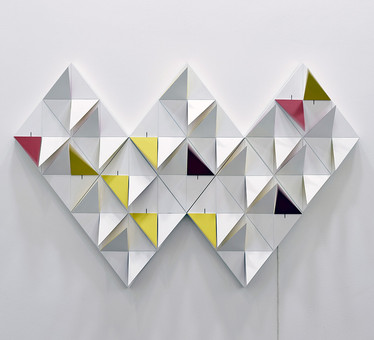LaB [au] - Painting, Writing, Calculating, Transcoding

São Paulo, Brasil
31/08/2024 - 30/10/2024
writing, painting, calculation, and transcoding
LaB [au] — Laboratoria de Arte de Urbanismo — is an artistic collective founded in 1997 by Manuel Abendroth and Jérôme Decock. Its network of collaborators includes artists such as Els Vermang (2003-2022) and Thibault
Drouillon (since 2023), among others. His works dialogue with conceptual, systemic and concrete art, made with current materials, techniques, and formats. Adepts of a reductionist, serial and elementary language, marked by the use of color, geometry, light, and movement, the group investigates and questions contemporary aesthetics, contrasting it with algorithmic logic.
LaB [au] uses terms such as modalities, systems, and concepts to define and structure its artistic production over the past 25 years. The modalities, for example, are used to distinguish art installations from architectural integrations, distinct artistic structures that crystallized from their theoretical research, experimental, contextual and visual. These aspects are also present in the name of the studio/collective
LaB [au], a mot-valise of “lab” [laboratory], a place of research, and of the German word bau, which means
construction, also referring to the studio’s origins as an architectural firm, a central element of its
practice to date.
Based on algorithmic logic, LaB [au] developed its own classification for systems
used in their projects, distinguishing them between closed, semi-open and open, finite and infinite systems. A
The permutation of these properties allows for a wide variety of combinations that form the basis of his artistic “taxonomy”. The ChronoPrints series, for example, is built from a finite, closed analytical system that assigns the primary colors of light to the basic units of time, following the equation: red = hours,
green = minutes, blue = seconds. From this equation, a computer prints small colored squares
on a surface, which together form a temporal texture, a chromatic gradient of time. Esses
calculations visualize the relationship between color and time, revisiting and re-signifying one of painting’s main themes
classical.
The collective also investigates the relationship between art and language, not only through the written word or through
other forms of semantic coding, but also through signs, or semiotics, elaborating a
dynamic artistic approach centered on the transposition of elements of information science and communication
for the art field. Like a lexicographer, LaB [au] writes books and builds libraries, exploring
infinite formal combinations, enumerating every possible way to fill in a blank page in its entirety. Not by chance, many of LaB’s works [au] are born from concepts specific to the art field, such as monochrome. The ultimate expression of painting, monochrome serves as a starting point for questioning the limits of language, since the meanings of monochrome — such as the fascination with emptiness — transcend its
literal definition, demanding a more comprehensive understanding of art. In this way, the group explores
tradition of painting through its terminology, inserting it, at the same time, in a more cultural context
expansive.
Since any language can be recoded in other media, LaB [au] uses colors, shapes, and patterns to
develop your own visual lexicon, exploring concepts of syntax, grammar, and vocabulary and deepening your
research on the possibilities of translating or transcoding artistic expression between different media. In his most recent work, LaB [au] creates an anagram using the names of certain colors to rethink the
meaning of the most basic and common element in pictorial art: color. By transcoding written language into a visual element, the group proposes a more comprehensive perception of color, connecting it to its history and etymology.
If the “modalities” are drawn mostly from the context of contemporary artistic practice, and the
“systems” are linked to the logic of the technologies and media used in the production of the works, the “concepts”, by
in turn, they provide a more thematic, subjective and personal reading of the collective’s works. In this way,
The concept spectr (a) um, or spectrum (s), is based on the elementary parameters of color, light, and sound, defining them
and relating them to time and space. The concept spectr (a) um, or spectrum (s), for example, is based on
elementary characteristics of color, light, and sound, relating them to the dimensions of time and space.
1600 Years of Light, a yellow energy field that occupies the center of the exhibition space, is a work in constant transformation that reveals the hidden relationship between color, space and time, exploring the
invisible spectrum of light. In the second part of the exhibition, we introduced the concept of RandomOrder, or
Random Order, to question formal rules and logics, contrasting them with the notions of order and randomness.
OrigamiLexicon explores several ways to fill in a blank page, based on calculations,
stochastic processes and other methods to explore and index these new forms of artistic expression. Essa
artistic attitude is summarized in the title of the exhibition, which cites primary artistic processes, contextualizing them in the contemporary world — a world where writing, drawing, painting, calculating and transcoding are forms of
reflect on the nature of art and our own existence
.